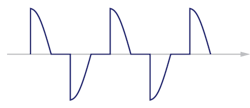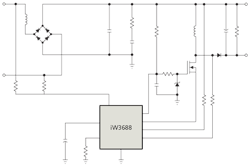While LED-based lamps are now selling in large volume, the performance of such solid-state lighting (SSL) products, especially in areas such as dimming, can still fall short of legacy bulbs. Indeed, conventional drivers designed for use in LED replacement lamps are having difficulty in delivering truly satisfactory dimming performance, energy efficiency, and reliability at an acceptable price. Digital control in the driver electronics, however, can now eliminate the wasteful bleeder resistors often used to enhance operation with legacy triac dimmers, while allowing flicker-free dimming down to low lighting levels.
Interested in more articles on LED drivers & electronics?
The use of dimmers with domestic lighting has become widespread, not only to save energy and reduce utility bills but also for comfort and convenience. With energy-saving LED lighting, dimming is not so important from an efficiency point of view. However, the desire to influence moods with lighting is strong, in homes and also in premises like restaurants, entertainment venues, or conference halls. This calls for smooth, flicker-free dimming, covering a wide range of light levels.
The ideal scenario for SSL deployment in many applications is simply to upgrade by replacing incandescent lamps with LED lamps of the same form factor. This is complicated by the fact that users expect the new lamps to operate perfectly with their existing dimmers, but results can vary depending on the type and quality of the dimmer in place.
Dimmer operation
Standard triac-based, phase-cut dimmers are designed to drive the resistive load presented by an incandescent bulb. The triac dimmer is otherwise known as a leading-edge dimmer, because dimming is achieved by blocking the leading edge of the applied AC voltage signal using the triac (Fig. 1). Delaying the firing angle of the triac causes the light to dim.
FIG. 1. Leading-edge dimming, by a triac-based dimmer, delays turn-on until late in the cycle.
When the firing pulse is applied, the triac turns on,and remains turned on for the remainder of the cycle, provided the current remains above the specified holding current for the device. If the load is an incandescent bulb, the current is easily maintained above the holding current threshold, therefore allowing the triac to remain on until the current reduces at the end of the cycle.
Two factors can limit the usable dimming range, however, and can even come into play with an incandescent bulb. The dimmer circuit typically incorporates an electromagnetic interference (EMI) filter, which contains inductor and capacitor components that can introduce ringing noise to the current waveform. If the inductor is a low-quality component, this ringing can be sufficient to cause the current immediately after turn-on to spike below the triac holding current, allowing the device to turn off and therefore causing visible flickering of the lamp. Similarly, if a low-cost triac with a relatively high holding current is used, the dimmer will be unable to sustain dimming levels where the current is below the holding current of the triac.
Fig. 2 illustrates the difference in minimum load current required by five popular triac-based dimmers that are currently available in the market. The spikes represent the minimum current that the LED driver would need to draw from the triac in order to ensure correct operation regardless of which dimmer is used.
LED load current
The challenges surrounding the operation of dimmers at low load currents are exacerbated when the load is an LED replacement bulb. Unlike an incandescent lamp, the LED is not purely resistive. Its impedance is reactive, and this can prevent the current from rising sufficiently above the triac holding current threshold to allow the device to remain on after the firing pulse is removed. Low levels of dimming can also be difficult to achieve, because the LED generally consumes less power than an incandescent bulb. Hence the current drawn through the triac can be very low at the phase angles needed for maximum dimming. The current can drop below the minimum holding current of the triac, causing the light to flicker or suddenly stop working when dimming is adjusted for very low light levels.
FIG. 2. Triac holding currents of five different dimmers.
In practice, dimmers need to achieve much greater levels of dimming than the casual observer is able to appreciate. Because the human eye compensates for low light levels by dilating the iris, the relationship between the electronic dimmer setting and the perceived dimming effect is not linear. If the dimmer is adjusted to reduce the light to 10% of its maximum measured level, the human eye will perceive a reduction only to around 30%. To achieve a perceived dimming level of 10%, the dimmer must be able to reduce the measured light level to only 1%. The Lighting Handbook, 10th Edition published by the Illuminating Engineering Society (IES) documents the relationship between perceived and measured light mathematically:
Perceived light = 100 × √(Measured light ÷ 100)
Manufacturers of LED replacement lamps need to be able to guarantee interoperability with triac dimmers of varying quality and cost, and ensure flicker-free lighting down to low dimming levels, in order to maximize customer satisfaction.
Bleeder circuits keep current flowing
A common solution is to add a bleeder circuit to maintain adequate current flow in the triac at lower dimming levels. This may be a passive circuit using a resistor or an active bleeder using power transistors to block current in the bleeder resistors when not needed.
Using a passive bleeder has two drawbacks. Since current passes through the resistor continuously, the efficiency advantage gained through using LED technology is eroded. Perhaps even more important is the effect of heat dissipation on the operating lifetime of the lamp. Thermal management is vitally important for LED lamps that must operate within the confines of existing industry-standard form factors. The LED emitters themselves are able to operate for lifetimes of 25,000 to 50,000 hours at high temperatures. However, associated components such as bulk electrolytic capacitors are more sensitive to operating temperature. For every 10°C rise in operating temperature, the lifetime of an electrolytic capacitor reduces by 50%. This degradation can significantly reduce the useful life of the LED lamp. To achieve an acceptable lifetime, manufacturers may need to take steps to protect vulnerable components - for example, by applying potting - which drives up the cost of the end product.
FIG. 3. An active bleeder circuit draws current only when needed but requires extra components and is difficult to control.
An active bleeder, as shown in Fig. 3, goes some way toward mitigating efficiency loss and temperature increase. Unlike the passive bleeder, the active circuit draws current only when the LED current is otherwise too low to keep the triac turned on. This avoids the burden of continuous power dissipation, which is imposed by the passive circuit, thereby improving efficiency and reducing thermal dissipation. On the other hand, active bleeder circuits are difficult to control and require a relatively high number of external components that increase overall cost. Moreover, although an active bleeder dissipates less power than a passive circuit, the principle is the same: Deliberately dissipating energy detracts from the efficiency advantages that are a major reason for the change to LED lighting.
Advantages of digital control
A more satisfactory approach is to recirculate bleeder current rather than dissipating the energy as heat. This is not easy to implement in the analog domain. However, digital technology permits complex dynamic control schemes that enable more intelligent use of the energy required to keep legacy dimmers operating correctly.
In addition to eliminating flicker or dropout when used with a conventional triac dimmer, a suitable LED-driver circuit must also manage AC-cycle inrush current to avoid momentary overloads, minimize audible noise resulting from interactions between the line cycle and internal magnetic components, and meet regulatory standards for power factor and electrical noise (EMI). They must also be compatible with the widest possible range of dimmer types.
Fig. 4 shows a representative application circuit for a non-isolated LED-driver circuit using the Dialog Semiconductor iW3688 controller. This device features a digital core and allows a low-cost solution that is compatible with a wide range of triac dimmers.
FIG. 4. Rectifier, current-control, and LED-driver circuitry implemented using the iW3688 controller.
As the diagram shows, the circuit uses only one external MOSFET. This is possible because the driver IC uses the same switch to keep the triac dimmer circuits working properly and to provide power for the control circuit itself. This design eliminates the need for a secondary winding on the main magnetic core, which is usually needed to power the controller. This approach gives designers the option to use low-cost, off-the-shelf inductors for non-isolated applications, or to use a standard flyback transformer if the application requires isolation. Such an architecture helps reduce component count, saves energy, and minimizes heat dissipation, thereby simplifying thermal management.
Driver operation
The IC's digital circuitry monitors the relevant voltages and currents and permits the controller to dynamically modulate the main power MOSFET to achieve the required level of dimming and keep the triac turned on even when the demand from the LED load is very low. Any additional current needed to keep the triac operating that is not already being drawn by the main power-conversion stage is used internally rather than being converted into heat.
The IC also integrates intelligent features that are capable of making dynamic impedance adjustments depending on the characteristics of the dimmer. The design allows the device to work with almost any standard triac dimmer and allows LED brightness to be dimmed down to 1% of maximum. The low dimming level enables a much stronger level of perceived dimming by humans compared to earlier driver circuits that were unable to support dimming below 5% or even 10%.
When no dimming is to be applied, the main power converter that delivers current to the LED load is operated in quasi-resonant mode to provide high power efficiency and low EMI. Power factor is also optimized to enhance efficiency and minimize current harmonic distortion on the AC line as well as to meet regulatory requirements around the world.
In dimming or no-dimming modes, the driver in the near future will be required to comply to emerging guidelines governing the flicker produced by lighting and SSL in particular. These include the IEEE 1789 recommendations, published earlier this year. Other bodies such as Energy Star are considering introducing flicker criteria. Among the proposals of IEEE 1789 is a limit on maximum acceptable flicker (see an article from this issue for more on flicker).
End users of energy-saving lighting expect a completely seamless transition from existing lighting technologies to LED replacements. This requires replacement bulbs to meet current industry-standard form factors, and to operate faultlessly with existing triac-based dimmers down to low dimming levels and within minimum flicker guidelines. At the same time, the new technology must be offered at a very competitive price, while also maximizing energy efficiency and reliability. Digital driver-control technology offers a superior solution compared to conventional analog circuitry and resistive bleeders, enabling manufacturers to meet such high expectations.
SCOTT BROWN is the senior director of marketing for the Power Conversion Business Group at Dialog Semiconductor (dialog-semiconductor.com).









